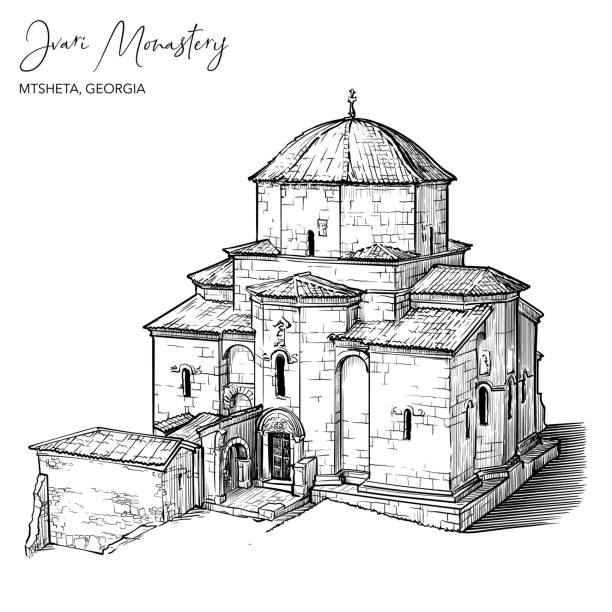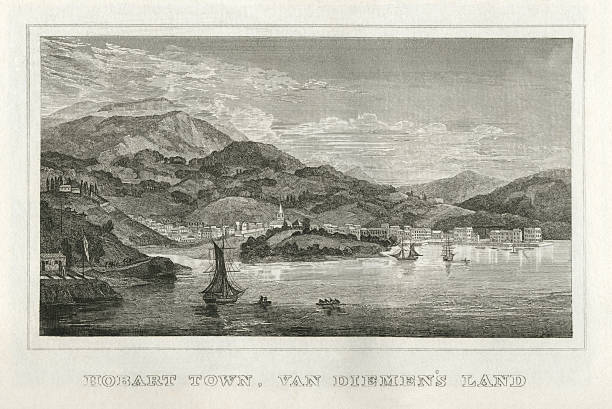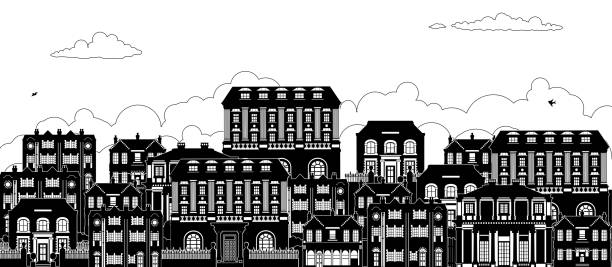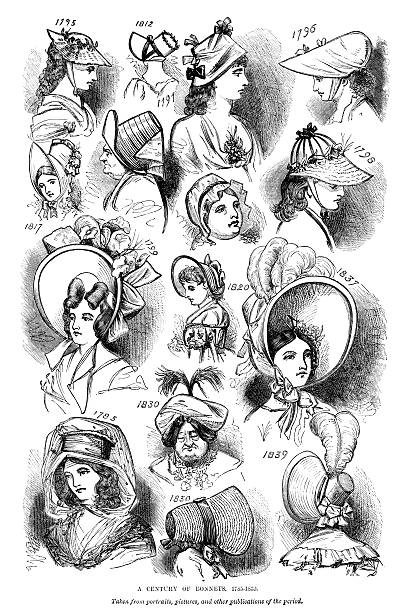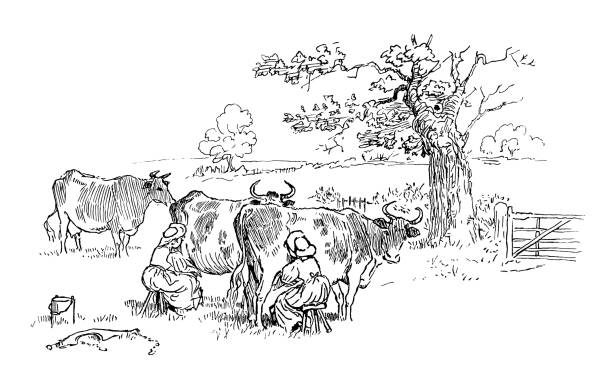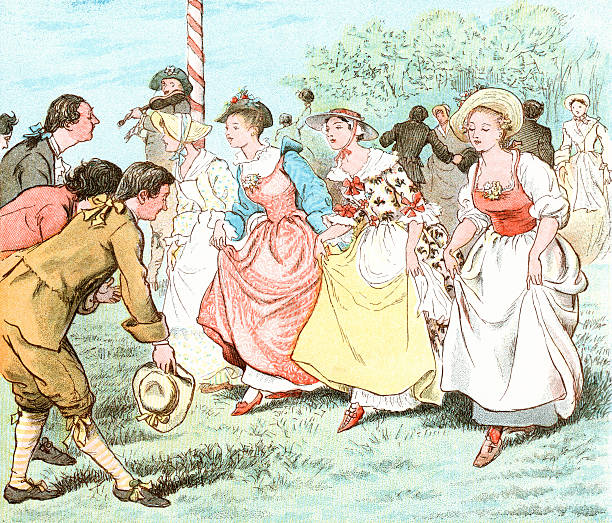
Georgian Era stock illustrations
Browse 340+ georgian era stock illustrations and vector graphics available royalty-free, or search for jane austen or georgian style to find more great stock images and vector art.

Vintage engraving of Elizabeth Ann Sheridan (nee Linley) and her brother, 1768. After Thomas Gainsborough. Elizabeth Ann Sheridan (née Linley) (September 1754 – 28 June 1792) was a singer who possessed great beauty.
Portrait of King George III
Illustration of a Westphalian spinning room of the modern age
Vintage illustration of Portrait of two Regency women, after Thomas Rowlandson. Thomas Rowlandson (13 July 1757 – 21 April 1827) was an English artist and caricaturist of the Georgian Era, noted for his political satire and social observation.
Illustration from 19th century.
Historical topographic map of the Caucasus Region. Lithograph, published in 1898.
An engraved vintage illustration portrait image of George III king of England, UK, from a Victorian book dated 1886 that is no longer in copyright
Jvari Monastery near city of Mtskheta in Georgia. Black line drawing isolated on white background.
Old-fashioned farm cart loaded with kvevri. Traditional Georgian wine making. Sketch style drawing isolated on white background. EPS 10 vector illustration
Old-fashioned farm cart loaded with kvevri. Traditional Georgian wine making. Sketch style drawing isolated on a watercolor textured background. EPS10 vector illustration
Illustration of a stagecoach is a type of covered wagon for passengers and goods
A view of the town and harbour of Hobart Town, Van Diemen’s Land (now known as Tasmania), an island to the south of the Australian mainland. Van Diemen’s Land was colonised by Britain in 1803 as a penal colony and became part of New South Wales in 1825. Hobart was then known as Hobart Town, or Hobarton and was named after Lord Hobart, the Colonial Secretary.
Metekhi Church and King Vakhtang Gorgasal Equisterian Statue in Tbilisi, Georgia. Poster style vector drawing. EPS10 vector illustration
A street with a row of houses in Victorian, Georgian and Edwardian styles in silhouette
Vintage illustration of Women's fashion of early 19th Century, High waisted dress, 1802
Engraving from "The Leisure Hour", No. 1367, 9th March 1878, a highly moral British publication, now in the public domain. This illustration - one of two - shows a collection of styles of British ladies' bonnets dating from 1785 to 1839.
Colour engraving of a street vendor sharpening knives, scissors and razors on a grindstone in the streets of Georgian era London, England, by Francis Wheatley c.1790.
Georgian traditional vineyard with kvevri. Countriside panorama on a background. Linear sketch on a watercolor textured background. EPS10 vector illustration
18th/19th century children's book engravings; childrens literature and story telling
Vintage illustration of Scene from The Great Panjandrum Himself, Illustrated by Randolph Caldecott. Young woman baking rolling out pastry
Old-fashioned farm cart loaded with kvevri. Traditional Georgian wine making. Black and white sketch isolated on white background. EPS10 vector illustration
"Vintage engraving of King George III (1738 - 1820) and Queen Charlotte of Great Britain. He was the third Hanoverian king of Great Britain. During his reign Britain lost its American colonies but emerged as a leading power in Europe. He suffered from recurrent fits of madness and after 1810, his son acted as regent."
Metekhi Church and King Vakhtang Gorgasal Equisterian Statue in Tbilisi, Georgia. Sketch style black line drawing isolated on white background. EPS10 vector illustration
An engraved illustration image of an old fashioned Georgian horsedrawn stagecoach full of travelling passengers from a Victorian book dated 1870 that is no longer in copyright
A young Georgian man bidding goodbye to his demure sweetheart at her garden gate, while her mother looks on with some degree of disapproval. From “R. Caldecott’s Second Collection of Pictures and Songs” containing “The Milkmaid”, “Hey Diddle Diddle”, Baby Bunting”, The Fox Jumps Over the Parson’s Gate”, “A Frog He Would a-Wooing Go”, “Come Lasses and Lads”, “Ride a Cock Horse…”, “A Farmer Went Trotting…”, “Mrs Mary Blaize” and “The Great Panjandrum Himself”. Drawn by Randolph Caldecott; engraved and printed by E. Evans. Published by George Routledge & Sons, London & New York, c1885.
Vintage engraving of Arthur Wellesley, 1st Duke of Wellington birthplace, Dublin, Ireland
A Georgian era men hanging up a the traditional three brass balls sign outside a pawn shop. From “R. Caldecott’s Second Collection of Pictures and Songs” containing “The Milkmaid”, “Hey Diddle Diddle”, Baby Bunting”, The Fox Jumps Over the Parson’s Gate”, “A Frog He Would a-Wooing Go”, “Come Lasses and Lads”, “Ride a Cock Horse…”, “A Farmer Went Trotting…”, “Mrs Mary Blaize” and “The Great Panjandrum Himself”. Drawn by Randolph Caldecott; engraved and printed by E. Evans. Published by George Routledge & Sons, London & New York, c1885.
Illustration from 19th century.
Arrest of the Cato Street Conspirators. The Cato Street Conspiracy was an attempt to murder all the British cabinet ministers and Prime Minister Lord Liverpool in 1820. The name comes from the meeting place near Edgware Road in London.
Two milkmaids sitting on milking stools to milk cows in a pasture. From “R. Caldecott’s Second Collection of Pictures and Songs” containing “The Milkmaid”, “Hey Diddle Diddle”, Baby Bunting”, The Fox Jumps Over the Parson’s Gate”, “A Frog He Would a-Wooing Go”, “Come Lasses and Lads”, “Ride a Cock Horse…”, “A Farmer Went Trotting…”, “Mrs Mary Blaize” and “The Great Panjandrum Himself”. Drawn by Randolph Caldecott; engraved and printed by E. Evans. Published by George Routledge & Sons, London & New York, c1885.
Vintage illustration of Scene from The Great Panjandrum Himself, Illustrated by Randolph Caldecott. Bear dressed in a dress walking down the street
Vintage illustration Ladies of the reign of George II, 18th Century women's fashion, Large wide skirts, Period costume
Vintage illustration Scene from Northanger Abbey by Jane Austen
Sioni Cathedral in Tbilisi, Georgia. Line drawing isolated on grunge watercolor textured background.
Georgian era people dancing beside the village May Pole on May Day to the music of a fiddler. From “R. Caldecott’s Second Collection of Pictures and Songs” containing “The Milkmaid”, “Hey Diddle Diddle”, Baby Bunting”, The Fox Jumps Over the Parson’s Gate”, “A Frog He Would a-Wooing Go”, “Come Lasses and Lads”, “Ride a Cock Horse…”, “A Farmer Went Trotting…”, “Mrs Mary Blaize” and “The Great Panjandrum Himself”. Drawn by Randolph Caldecott; engraved and printed by E. Evans. Published by George Routledge & Sons, London & New York, c1885.
An early 19th century view of Sydney (here spelled ‘Sidney’), New South Wales, Australia, from “A System of Geography, Popular and Scientific, or A Physical, Political, and Statistical Account of the World and its Various Divisions. Volume VI, Part II” by James Bell and published by A. Fullarton & Co., Glasgow, in 1838.
Vintage illustration of Scene from The Great Panjandrum Himself, Illustrated by Randolph Caldecott. Young woman walking through a vegetable garden
A nineteenth century woman studying cabbages in a vegetable garden. From “R. Caldecott’s Second Collection of Pictures and Songs” containing “The Milkmaid”, “Hey Diddle Diddle”, Baby Bunting”, The Fox Jumps Over the Parson’s Gate”, “A Frog He Would a-Wooing Go”, “Come Lasses and Lads”, “Ride a Cock Horse…”, “A Farmer Went Trotting…”, “Mrs Mary Blaize” and “The Great Panjandrum Himself”. Drawn by Randolph Caldecott; engraved and printed by E. Evans. Published by George Routledge & Sons, London & New York, c1885.
A creased and stained steel engraving of a map which shows “The Countries of the Ancient World Exhibiting the Probable Settlement of the Descendants of Noah”, from “A System of Geography, Popular and Scientific, or A Physical, Political, and Statistical Account of the World and its Various Divisions. Volume VI, Part II” by James Bell and published by A. Fullarton & Co., Glasgow, in 1838.
A group of Georgian people out for a walk. From “R. Caldecott’s Second Collection of Pictures and Songs” containing “The Milkmaid”, “Hey Diddle Diddle”, Baby Bunting”, The Fox Jumps Over the Parson’s Gate”, “A Frog He Would a-Wooing Go”, “Come Lasses and Lads”, “Ride a Cock Horse…”, “A Farmer Went Trotting…”, “Mrs Mary Blaize” and “The Great Panjandrum Himself”. Drawn by Randolph Caldecott; engraved and printed by E. Evans. Published by George Routledge & Sons, London & New York, c1885.
Georgian traditional vineyard with kvevri. Countriside panorama on a background. Black and white sketch isolated on white background. EPS10 vector illustration
A group of excited Georgian ladies about to sample bowls of tea which are being poured out for them. Tea was an expensive luxury in the 18th century, so it is likely that these ladies had never sampled it before. Teacups did not have handles in those days and were known as teabowls. From “R. Caldecott’s Second Collection of Pictures and Songs” containing “The Milkmaid”, “Hey Diddle Diddle”, Baby Bunting”, The Fox Jumps Over the Parson’s Gate”, “A Frog He Would a-Wooing Go”, “Come Lasses and Lads”, “Ride a Cock Horse…”, “A Farmer Went Trotting…”, “Mrs Mary Blaize” and “The Great Panjandrum Himself”. Drawn by Randolph Caldecott; engraved and printed by E. Evans. Published by George Routledge & Sons, London & New York, c1885.
Vintage colour print of men selling ginderbread from a barrow on the streets of Old London, England. c.1797
The Coronation of King George IV, Westminster Hall in London - the Champion's Challenge. The Sovereign’s Champion would ride, fully armoured, into Westminster Hall, where he would throw down the Gauntlet at the entrance, the middle of the Hall and again at the Throne, repeating his challenge on each occasion. The purpose was to discover whether the new Monarch had any competition for his or her title to the Throne. From “Old & New London” by Walter Thornbury and Edward Walford, published in parts by Cassell & Co, London from 1873-1888. These illustrations are from parts 30-35 inclusive.
history, vintage, illustration, retro style, 19th Century Style, old, only women, wine, Georgia
Vintage illustration of Scene from An Elegy on the Glory of Her Sex, Mrs. Mary Blaize by Oliver Goldsmith, Illustrated by Randolph Caldecott.
Entry of King George IV into Dublin, Ireland
Vintage colour print of young woman selling strawberrys on the streets of Old London, England. c.1797
Map of Asia with a retro style, a vintage effect on an old textured paper.
Seamless pattern. Georgian traditional vineyard with kvevri. Countriside panorama on a background. Black and white sketch style drawing. EPS10 vector illustration
Ananuri fortress in Mtskheta-Mtianeti region in Georgia. Black line drawing isolated on white background.
A smartly dressed Georgian era woman asleep in a church box pew, while other members of the congregation look on disapprovingly. From “R. Caldecott’s Second Collection of Pictures and Songs” containing “The Milkmaid”, “Hey Diddle Diddle”, Baby Bunting”, The Fox Jumps Over the Parson’s Gate”, “A Frog He Would a-Wooing Go”, “Come Lasses and Lads”, “Ride a Cock Horse…”, “A Farmer Went Trotting…”, “Mrs Mary Blaize” and “The Great Panjandrum Himself”. Drawn by Randolph Caldecott; engraved and printed by E. Evans. Published by George Routledge & Sons, London & New York, c1885.
Set characters of different nationalities in national costumes.
history, vintage, illustration, retro style, 19th Century Style, old, only women, smoking, Georgia,
Vintage illustration of Early 19th Century fashion, smartly dressed young couple, 1804







